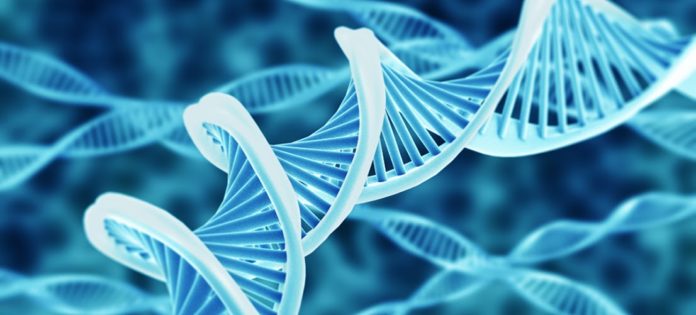
Scientists in the UK have identified a novel gene that, when mutated, can drive development and progression of triple-negative breast cancer — an aggressive form of the disease that accounts for up to one in five breast cancer cases. The team reported their findings this week in the journal Nature Communications.
Breast cancer is often referred to as a single disease, but in fact, there are actually many types of breast cancers, all of which respond differently to treatments and have different prognoses. After an initial diagnosis, all breast cancer tumors are tested for three receptors (proteins): 1) estrogen receptors; 2) progesterone receptors; and 3) human epidermal growth factor (HER2) receptors.
Triple-negative breast cancer gets its name because the tumor cells test negative for all three hormone receptors. As such, triple-negative breast cancer does not respond to hormone therapy, meaning individuals with this subtype have a poorer prognosis than those with other subtypes. Basal cell breast cancer is the most common form of triple-negative breast cancer.
New treatments are being explored, but the options for patients with triple-negative breast cancer remain limited, in large part because the genes linked to the disease are not well understood at this time and thus, targeted therapies do not yet exist. While much research has focused on identifying these genes, to date, very few have been found.
‘It had all the hallmarks of a novel breast cancer gene’
In this latest study, researchers from the Wellcome Trust Sanger Institute and the University of Cambridge in the UK took a novel approach to investigating the genetic underpinnings of triple-negative breast cancer: they examined changes to genes that affect the behavior of stem cells and developing tissues, citing previous research which suggests that these mutations often drive cancer development.
“Our understanding of genes that drive stem cell development led us to search for consequences when these genes go wrong,” explains Dr. Pentao Liu, lead author on the study, from the Wellcome Trust Sanger Institute.
The researchers looked at these gene changes in breast cancer cells from nearly 3,000 patients, finding that a gene called BCL11A was particularly active in triple-negative breast cancer. “It had all the hallmarks of a novel breast cancer gene,” says Dr. Liu.
Higher activity of the BCL11A gene was found in approximately eight out of ten patients with basal-like breast cancer and was associated with a more advanced grade of tumor. In cases where additional copies of the BCL11A gene were created in the cancer, the prospects for survival of the patient were diminished, the researchers found.
“Our gene studies in human cells clearly marked BCL11A as a novel driver for triple-negative breast cancers,” says Dr. Walid Khaled, joint first author on the study, from the Wellcome Trust Sanger Institute and University of Cambridge.
Cells lost cancer-like properties with reduced BC11A activity
After identifying the novel gene, the researchers wanted to see how breast cells from both humans and mice would react if they introduced an active human BCL11A gene. When they did so, they found that it caused the breast cells to behave as cancer cells.
What’s more, when the researchers reduced BCL11A activity in three samples of human triple-negative breast cancer cells, the cells lost some of their cancer-like characteristics. And when these cells were introduced to mice, they exhibited diminished capacity to drive tumor growth.
“So by increasing BCL11A activity we increase cancer-like behavior; by reducing it, we reduce cancer-like behavior,” explains Dr. Khaled.
The researchers confirmed those findings in further experiments in mice, demonstrating that when the rodents’ BCL11A genes were inactivated, tumor growth was stalled in their mammary gland. Mice that did not have this gene inactivated, however, developed tumors.
The team also showed that BCL11A is required for normal development of breast stem cells and progenitors, which are thought to be the cells that, when mutated, give rise to basal-like breast cancer.
BCL11A may be a ‘strong candidate’ for targeted therapies
Based on these new findings, the team propose that BCL11A may be a “strong candidate” for development of a targeted treatment. While further research is needed, the prospect of developing a targeted therapy for triple-negative breast cancer could be a game-changer for patients with this aggressive disease.
“This exciting result identifies a novel breast cancer gene in some of the more difficult-to-treat cases,” says Dr. Carlos Caldas, Professor of Cancer Medicine and Director of the Cambridge Breast Cancer Research Unit at the University of Cambridge, and Head of Breast Cancer Functional Genomics at Cancer Research UK Cambridge Institute.
“It builds on our work to develop a comprehensive molecular understanding of breast cancer that will inform clinical decisions and treatment choices,” adds Dr. Caldas. “Finding a novel gene that is active in cancer should also help in the search for new treatments.”
While treatment options remain limited for women with triple negative breast cancer, scientists have made a number of recent discoveries that could open the door for entirely new approaches to treating the disease.
In one particularly innovative study published in June, researchers from Penn State College of Medicine found that Adeno-associated virus type 2 (AAV2) — a virus that infects humans but is not known to cause sickness — can kill triple-negative breast cancer cells in mice. The virus initiated apoptosis — natural cell death — in cancer cells without affecting healthy cells. Furthermore, the virus also killed tumors grown from these cells in mice. The researchers are hopeful that insights from this discovery will eventually lead to more targeted treatments for the aggressive cancer.
